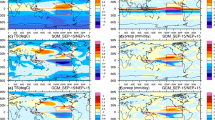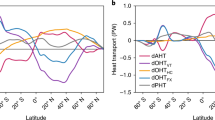Abstract
This study investigates the effect of ocean dynamics on the tropical climate response to localized radiative cooling over three northern extratropical land regions using hierarchical model simulations that vary in the degree of ocean coupling. Without ocean dynamics, the tropical climate response is independent of the extratropical forcing location, characterized by a southward tropical precipitation shift with a high degree of zonal symmetry, a reduced zonal sea surface temperature gradient along the equatorial Pacific, and the eastward-shifted Walker circulation. When ocean dynamical adjustments are allowed, the zonal-mean tropical precipitation shift is damped primarily via Eulerian-mean ocean heat transport. The oceanic damping effect is strongest (weakest) for North Asian (American) cooling, associated with the largest (smallest) Eulerian-mean ocean heat transport across the equatorial Pacific. The cross-equatorial ocean heat transport in the Pacific is anchored to the North Pacific subtropical high, the response of which can be inferred from the corresponding slab ocean simulations. Hence, the slab ocean simulations provide useful a priori prediction for oceanic damping efficiency. Ocean dynamics also modulates the spatial pattern of climate response in a distinct manner depending on the zonal distribution of imposed forcing. North Asian forcing induces a pronounced eastern equatorial Pacific cooling extending to the western basin, accompanying the westward shifted Walker circulation. European forcing causes cooling confined to the eastern equatorial Pacific and strengthens the Walker circulation. The tropical precipitation response in these two cases exhibits large zonal variations with a high degree of equatorial symmetry, being essentially uncorrelated with the corresponding slab ocean simulations. By contrast, North American forcing induces a sufficiently strong inter-hemispheric contrast in the tropical Pacific SST response, due to the relatively weak oceanic damping effect, producing a weaker but spatially similar tropical response to that in the slab ocean simulation. This study demonstrates that the effect of ocean dynamics in modulating the tropical climate response depends on the extratropical forcing location. The results are relevant for understanding the distinct climate response induced by aerosols from different continental sites.











Similar content being viewed by others
Data availability
The regional cooling experiment data in this study can be obtained at the following https://doi.org/10.5281/zenodo.6355053.
Code availability
Not applicable.
References
Clark SK, Ming Y, Held IM, Phillipps PJ (2018) The role of the water vapor feedback in the ITCZ response to hemispherically asymmetric forcings. J Clim 31:3659–3678
Deser C, Tomas RA, Sun L (2015) The role of ocean–atmosphere coupling in the zonal-mean atmospheric response to arctic sea ice loss. J Clim 28:2168–2186. https://doi.org/10.1175/JCLI-D-14-00325.1
Deser C, Phillips AS, Simpson IR et al (2020) Isolating the evolving contributions of anthropogenic aerosols and greenhouse gases: a new CESM1 large ensemble community resource. J Clim 33:7835–7858. https://doi.org/10.1175/JCLI-D-20-0123.1
Diao C, Xu Y, Xie S-P (2021) Anthropogenic aerosol effects on tropospheric circulation and sea surface temperature (1980–2020): separating the role of zonally asymmetric forcings. Atmos Chem Phys 21:18499–18518. https://doi.org/10.5194/acp-21-18499-2021
Forster P et al (2007) Changes in Atmospheric Constituents and in Radiative Forcing Chapter 2. United Kingdom: Cambridge University Press
Green B, Marshall J, Campin J-M (2019) The ‘sticky’ ITCZ: ocean-moderated ITCZ shifts. Clim Dyn 53:1–19. https://doi.org/10.1007/s00382-019-04623-5
Hawcroft M, Haywood JM, Collins M et al (2017) Southern Ocean albedo, inter-hemispheric energy transports and the double ITCZ: global impacts of biases in a coupled model. Clim Dyn 48:2279–2295. https://doi.org/10.1007/s00382-016-3205-5
Hirasawa H, Kushner PJ, Sigmond M et al (2020) Anthropogenic aerosols dominate forced multidecadal sahel precipitation change through distinct atmospheric and oceanic drivers. J Clim 33:10187–10204. https://doi.org/10.1175/JCLI-D-19-0829.1
Hoskins BJ, Karoly DJ (1981) The steady linear response of a spherical atmosphere to thermal and orographic forcing. J Atmos Sci 38:1179–1196. https://doi.org/10.1175/1520-0469(1981)038%3c1179:TSLROA%3e2.0.CO;2
Hwang Y-T, Frierson DMW, Kang SM (2013) Anthropogenic sulfate aerosol and the southward shift of tropical precipitation in the late 20th century. Geophys Res Lett 40:2845–2850. https://doi.org/10.1002/grl.50502
Hwang Y-T, Xie S-P, Deser C, Kang SM (2017) Connecting tropical climate change with Southern Ocean heat uptake. Geophys Res Lett 44:9449–9457. https://doi.org/10.1002/2017GL074972
Kang SM (2020) Extratropical influence on the tropical rainfall distribution. Curr Clim Change Rep 6:24–36. https://doi.org/10.1007/s40641-020-00154-y
Kang SM, Held IM, Frierson DMW, Zhao M (2008) The response of the ITCZ to extratropical thermal forcing: idealized slab-ocean experiments with a GCM. J Clim 21:3521–3532. https://doi.org/10.1175/2007JCLI2146.1
Kang SM, Held IM, Xie S-P (2014) Contrasting the tropical responses to zonally asymmetric extratropical and tropical thermal forcing. Clim Dyn 42:2033–2043. https://doi.org/10.1007/s00382-013-1863-0
Kang SM, Park K, Hwang Y-T, Hsiao W-T (2018) Contrasting tropical climate response pattern to localized thermal forcing over different ocean basins. Geophys Res Lett 45:12544–12552. https://doi.org/10.1029/2018aGL080697
Kang SM, Shin Y, Xie S-P (2018) Extratropical forcing and tropical rainfall distribution: energetics framework and ocean Ekman advection. NPJ Clim Atmos Sci. https://doi.org/10.1038/s41612-017-0004-6
Kang SM, Hawcroft M, Xiang B et al (2019) Extratropical-tropical interaction model intercomparison project (Etin-Mip): protocol and initial results. Bull Am Meteor Soc 100:2589–2606. https://doi.org/10.1175/BAMS-D-18-0301.1
Kang SM, Xie S-P, Shin Y et al (2020) Walker circulation response to extratropical radiative forcing. Sci Adv. https://doi.org/10.1126/sciadv.abd3021
Kang SM, Xie S-P, Deser C, Xiang B (2021) Zonal mean and shift modes of historical climate response to evolving aerosol distribution. Sci Bull. https://doi.org/10.1016/j.scib.2021.07.013
Kay JE, Wall C, Yettella V et al (2016) Global climate impacts of fixing the Southern Ocean shortwave radiation bias in the community earth system model (CESM). J Clim 29:21
Kim H, Pendergrass AG, Kang SM (2022) The dependence of mean climate state on shortwave absorption by water vapor. J Clim 35:2189–2207
L’Hévéder B, Codron F, Ghil M (2015) Impact of anomalous northward oceanic heat transport on global climate in a Slab Ocean setting. J Climate 28:2650–2664. https://doi.org/10.1175/JCLI-D-14-00377.1
Ming Y, Ramaswamy V (2009) Nonlinear climate and hydrological responses to aerosol effects. J Clim 22:1329–1339. https://doi.org/10.1175/2008JCLI2362.1
Samset BH, Lund MT, Bollasina M et al (2019) Emerging Asian aerosol patterns. Nat Geosci 12:582–584. https://doi.org/10.1038/s41561-019-0424-5
Seo J, Kang AM, Frierson DMW (2014) Sensitivity of intertropical convergence zone movement to the latitudinal position of thermal forcing. J Clim 27:3035–3042. https://doi.org/10.1175/JCLI-D-13-00691.1
Shi JR, Kwon YO, Wijffels SE (2022) Two distinct modes of climate responses to the anthropogenic aerosol forcing changes. J Clim. https://doi.org/10.1175/JCLI-D-21-0656.1
Taylor KE, Crucifix M, Braconnot P et al (2007) Estimating shortwave radiative forcing and response in climate models. J Clim 20:2530–2543. https://doi.org/10.1175/JCLI4143.1
Tilmes S, Fasullo J, Lamarque J-F et al (2013) The hydrological impact of geoengineering in the Geoengineering Model Intercomparison Project (GeoMIP). J Geophys Res Atmos 118:11036–11058. https://doi.org/10.1002/jgrd.50868
Vecchi GA, Delworth T, Gudgel R et al (2014) On the seasonal forecasting of regional tropical cyclone activity. J Clim 27:7994–8016. https://doi.org/10.1175/JCLI-D-14-00158.1
Wang H, Wen Y-J (2021) Climate response to the spatial and temporal evolutions of anthropogenic aerosol forcing. Clim Dyn 59(5):1579–1595
Wang Y, Jiang JH, Su H (2015) Atmospheric responses to the redistribution of anthropogenic aerosols. J Geophys Res Atmos 120:9625–9641. https://doi.org/10.1002/2015JD023665
Wang H, Xie S, Tokinaga H et al (2016) Detecting cross-equatorial wind change as a fingerprint of climate response to anthropogenic aerosol forcing. Geophys Res Lett 43:3444–3450. https://doi.org/10.1002/2016GL068521
Wang Y, Jiang JH, Su H, Choi Y-S, Huang L, Guo J, Yung YL (2018) Elucidating the role of anthropogenic aerosols in Arctic Sea ice variations. J Clim 31:99–114. https://doi.org/10.1175/JCLI-D-17-0287.1
White RH, McFarlane AA, Frierson DMW et al (2018) Tropical precipitation and cross-equatorial heat transport in response to localized heating: basin and hemisphere dependence. Geophys Res Lett 45:11949–11958. https://doi.org/10.1029/2018GL078781
Xiang B, Zhao M, Ming Y et al (2018) Contrasting impacts of radiative forcing in the Southern Ocean versus Southern Tropics on ITCZ position and energy transport in one GFDL climate model. J Clim 31:5609–5628. https://doi.org/10.1175/JCLI-D-17-0566.1
Xie S-P, Philander SGH (1994) A coupled ocean-atmosphere model of relevance to the ITCZ in the eastern Pacific. Tellus A 46:340–350. https://doi.org/10.1034/j.1600-0870.1994.t01-1-00001.x
Xie S-P, Lu B, Xiang B (2013) Similar spatial patterns of climate responses to aerosol and greenhouse gas changes. Nat Geosci 6:828–832. https://doi.org/10.1038/ngeo1931
Yu S, Pritchard MS (2019) A strong role for the AMOC in partitioning global energy transport and shifting ITCZ position in response to latitudinally discrete solar forcing in CESM1.2. J Clim 32:2207–2226. https://doi.org/10.1175/JCLI-D-18-0360.1
Zhao M, Golaz J-C, Held IM et al (2018) The GFDL global atmosphere and land model AM4.0/LM4.0: 1. Simulation characteristics with prescribed SSTs. J Adv Model Earth Syst 10:691–734. https://doi.org/10.1002/2017MS001208
Funding
S.M.K., J.K., and D.K. were supported by the National Research Foundation of Korea (NRF) grant (NRF-2020K2A9A2A06070756) funded by the Ministry of Science and ICT (MSIT) of South Korea. S.P.X. was supported by the National Science Foundation (AGS-1934392). X.T.Z. was supported by the National Natural Science Foundation of China (41975092).
Author information
Authors and Affiliations
Contributions
JK, SMK, and SPX developed the idea for this study. SMK, SPX, and BX designed the model experiments. BX performed the model experiments. JK, SMK, and DK conducted the data analysis, with input and feedback from SPX, BX, XTZ, and HW. JK and SMK prepared the manuscript, with contributions from all authors.
Corresponding author
Ethics declarations
Conflict of interest
The authors declare no competing interests.
Additional information
Publisher's Note
Springer Nature remains neutral with regard to jurisdictional claims in published maps and institutional affiliations.
Rights and permissions
Springer Nature or its licensor holds exclusive rights to this article under a publishing agreement with the author(s) or other rightsholder(s); author self-archiving of the accepted manuscript version of this article is solely governed by the terms of such publishing agreement and applicable law.
About this article
Cite this article
Kim, J., Kang, S.M., Xie, SP. et al. Large-scale climate response to regionally confined extratropical cooling: effect of ocean dynamics. Clim Dyn 60, 3291–3306 (2023). https://doi.org/10.1007/s00382-022-06500-0
Received:
Accepted:
Published:
Issue Date:
DOI: https://doi.org/10.1007/s00382-022-06500-0




